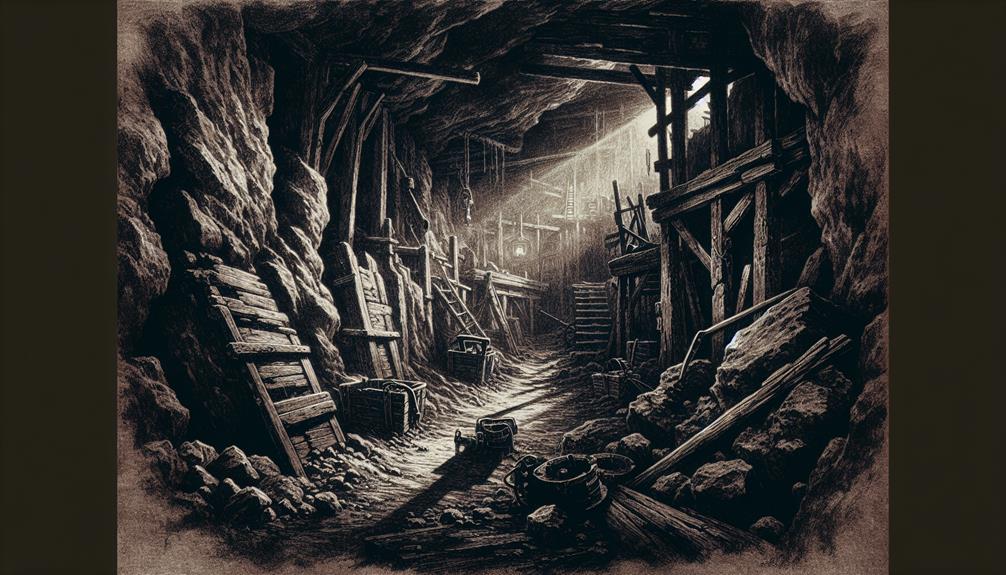Nevada's mining ghost towns have negative impacts on the environment. Toxic waste from abandoned mines affects soil, water, and air quality. Contamination can lead to health issues like respiratory problems and cancer. Water quality is affected by heavy metals like lead and arsenic, harming aquatic ecosystems. Wildlife habitats are destroyed, disrupting biodiversity. Soil contamination with heavy metals poses risks to agriculture and health. Remediation efforts involve challenges like cost and effectiveness. The legacy of pollution, water contamination, habitat destruction, and soil degradation lingers in Nevada's mining ghost towns.
Key Points
- Toxic waste from abandoned mines contaminates soil, water, and air, posing health risks.
- Water quality in Nevada ghost towns is affected by heavy metal leaching.
- Wildlife habitats are destroyed, leading to biodiversity loss.
- Soil contamination with heavy metals like lead persists, impacting ecosystems.
- Remediation efforts in remote locations face challenges of cost and effectiveness.
Pollution From Abandoned Mines
Abandoned mines in Nevada are significant sources of pollution, impacting the environment and nearby communities. These sites often contain toxic waste materials that pose serious risks to public health. When left unchecked, these abandoned mines can contaminate soil, water sources, and the air, leading to a range of health issues for both humans and wildlife.
Toxic waste from these mines can leach into the ground, affecting soil quality and potentially entering the food chain. This contamination can lead to vital health problems such as respiratory issues, neurological disorders, and even cancer. Additionally, the proximity of these abandoned mines to residential areas increases the exposure risk to nearby communities, compounding the public health concerns.
Addressing the pollution from abandoned mines is essential to safeguarding the environment and protecting public health. Remediation efforts must be undertaken to mitigate the impacts of toxic waste and prevent further harm to both the ecosystem and the people living in the vicinity of these mines.
Impact on Water Quality
The impact on water quality from Nevada mining ghost towns is a pressing environmental concern due to the contamination caused by toxic waste materials leaching into water sources. This contamination poses a significant threat to water conservation efforts and the health of aquatic ecosystems in the region. The presence of heavy metals such as lead, arsenic, and mercury in the water can have detrimental effects on aquatic life and water quality.
Water conservation initiatives are vital to mitigating the impact of mining ghost towns on water quality. Implementing effective water management strategies can help reduce the spread of contaminants and protect water sources from further degradation. Monitoring water quality regularly and implementing proper treatment measures are essential steps towards safeguarding the health of aquatic ecosystems in the area.
Ensuring the preservation of water quality in regions affected by mining ghost towns is crucial for the overall well-being of the environment and the communities relying on these water sources. By prioritizing water conservation efforts and implementing sustainable practices, we can work towards restoring and maintaining the health of aquatic ecosystems impacted by mining activities.
Wildlife Habitat Destruction
With wildlife habitats being destroyed by mining activities in Nevada ghost towns, the ecosystem faces significant disruption and loss of biodiversity. Habitat fragmentation, caused by mining operations, leads to the destruction of natural environments essential for various species' survival. As habitats are broken into smaller, isolated patches, wildlife struggles to find food, shelter, and mates, ultimately reducing their chances of long-term survival.
The process of habitat fragmentation disrupts the balance of ecosystems, impacting the interconnected web of life. Species that once thrived in these areas face challenges in finding suitable habitats, leading to population declines and, in some cases, local extinctions. The reduction in biodiversity due to habitat destruction affects the ecosystem's resilience and ability to adapt to environmental changes.
To mitigate the effects of wildlife habitat destruction, conservation efforts are vital. Restoring fragmented habitats and creating wildlife corridors can help reconnect isolated patches, allowing species to move freely and maintain genetic diversity. By addressing habitat fragmentation and biodiversity loss, we can work towards preserving the rich wildlife heritage of Nevada's mining ghost towns.
Soil Contamination Concerns
Habitat fragmentation caused by mining activities in Nevada ghost towns has led to significant concerns regarding soil contamination. The soil in these areas may contain heavy metals such as lead, arsenic, and mercury, posing health risks to both humans and wildlife. When mining operations cease, these contaminants can persist in the soil for extended periods, affecting local ecosystems.
Soil contamination also has detrimental effects on agriculture in Nevada ghost towns. Contaminants present in the soil can be taken up by plants, potentially entering the food chain and posing risks to human health. Crops grown in contaminated soil may have reduced yields or be unfit for consumption, impacting local farmers and food security.
To address soil contamination concerns, thorough testing and monitoring of soil quality are essential. Remediation efforts may include soil removal, treatment, or the implementation of barriers to prevent further contamination. It's important to mitigate soil contamination to safeguard the environment, human health, and agricultural productivity in Nevada mining ghost towns.
Remediation Efforts and Challenges
Addressing soil contamination in Nevada mining ghost towns requires strategic remediation efforts to overcome significant challenges. One of the primary challenges faced in remediating these sites is the extent of contamination, which often involves heavy metals like lead, arsenic, and mercury. These contaminants pose serious health risks to both humans and wildlife and necessitate thorough cleanup.
Remediation techniques commonly employed include soil excavation, where contaminated soil is removed and treated off-site, and soil washing, which uses chemical solutions to extract contaminants. However, these methods can be costly and may not always completely eliminate the pollution.
Another challenge is the long-term monitoring and maintenance required post-remediation to make certain that the contamination doesn't resurface. Additionally, the remote locations of many mining ghost towns make access and logistics difficult for remediation efforts.
Despite these challenges, ongoing research and technological advancements offer hope for more effective and sustainable remediation solutions in the future.
Frequently Asked Questions
How Do Mining Ghost Towns in Nevada Impact Local Tourism and Economy?
When visiting Nevada mining ghost towns, you'll notice their economic impact on local tourism. These towns, abandoned yet rich in history, present opportunities for community revitalization through heritage tourism, attracting visitors and bolstering the local economy.
Are There Any Health Risks Associated With Living Near Abandoned Mines in Nevada?
Living near abandoned mines in Nevada poses health risks due to potential exposure to toxic substances like lead and arsenic. Environmental impacts include contaminated soil and water, affecting both residents and wildlife. Stay informed and cautious.
What Measures Are Being Taken to Preserve Historical and Cultural Sites Within Mining Ghost Towns?
To maintain the historical significance of mining ghost towns, preservation efforts focus on safeguarding structures and artifacts. These initiatives aim to protect and promote the cultural heritage of these sites, ensuring their legacy endures.
How Do Mining Ghost Towns Affect Air Quality in the Surrounding Areas?
When you explore how mining ghost towns affect air quality in surrounding areas, you'll find that these abandoned sites contribute to air pollution. Remediation efforts are essential to mitigate environmental impacts and protect public health.
Are There Any Plans to Repurpose Abandoned Mines in Nevada for Sustainable Development or Renewable Energy Projects?
You can find various plans to repurpose abandoned mines in Nevada for sustainable development and renewable energy projects. These initiatives aim to utilize the existing infrastructure to support the growth of renewable energy sources and promote sustainable practices.



